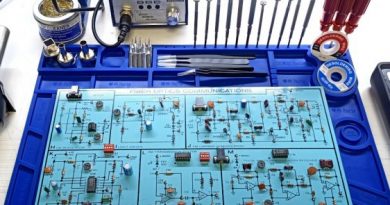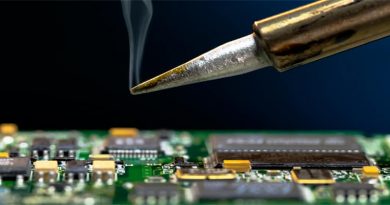Soldering Stations and the Solder Pot
A Solder Pot is an extremely useful but scarcely used soldering station that can be the most effective method for removing and replacing components with a large number of leads (such as connectors, headers , and switches). It can also be used for tinning wires and mass soldering of Printed Circuit Boards (PCBs). The Circuit Specialists model BK3050 Solder Pot was used to remove several 96 pin connectors from a large mother board. The same technique can be used to remove electrolytic capacitors from computer mother boards and video game consoles that have a large ground plane that makes soldering and de-soldering difficult.
The Solder pot is filled with solder to the capacity of the pot (approximately 7 lbs. for the BK30500). The solder pot should be full to the top edge of the container. Scrape off any impurities from the solder surface with a steel spatula, once the solder is completely molten. Hold the circuit board with the connector to be removed over the solder pot so that the connector leads on the bottom side of the PCB are immersed in the molten solder. Once the solder on the connector leads has melted lift up the connector with one swift motion and remove the PCB from the solder surface. You may clean out any solder that remains in the holes in the PCB by lightly tapping the PCB against the edge of the workbench or table. This must be done immediately after removing the PCB from the solder pot so that the solder in the holes is not yet solidified. If necessary, any remaining solder may be removed with a vacuum solder pump or solder wick. The new connector may be re-installed by applying flux to the connector after it is inserted in the PCB and briefly dipping the underside of the PCB with connector into the molten solder. The procedure for mass soldering populated PCBs is similar to that described for re-installing the multi-pin connector. Install the leaded components in the PCB and crimp the leads so the components don’t fall out. Apply flux to the bottom side of the PCB (and the component leads) and dip the bottom side of the PCB into the surface of the molten solder. You should be able to see the molten solder wick up through the holes and the component leads on a double sided PCB. You can then perform any soldering touch up that is required and clean the flux off of the PCB using isopropyl alcohol or flux cleaner.
The Solder Pot is a versatile tool that is indispensable for removing large pin count leaded components and can also be used to simplify and speed-up soldering of through hole PCBs.


